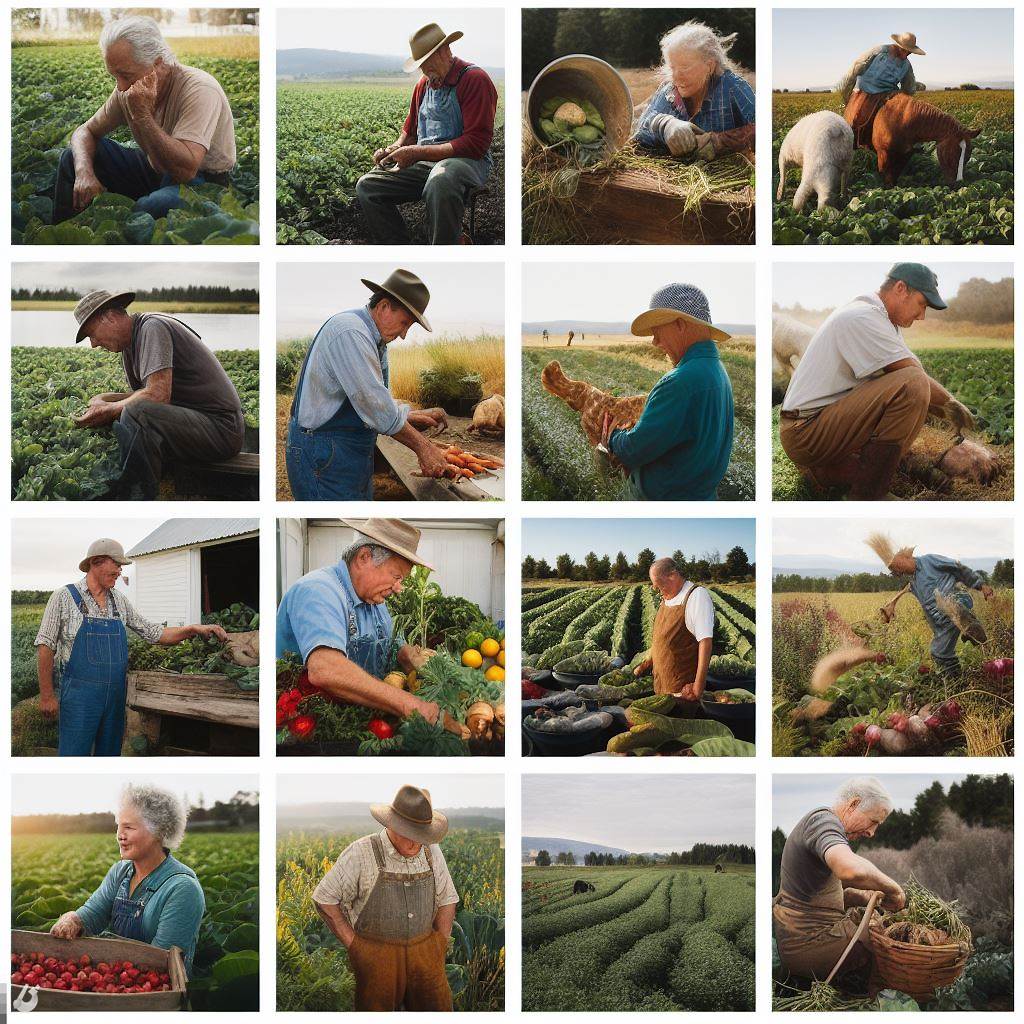Introduction
Farm-to-table dining has gained popularity in recent years, with many restaurants and individuals embracing the concept.
But what exactly does it mean?
At its core, farm-to-table is about connecting consumers with the source of their food.
Rather than relying on a chain of middlemen, farm-to-table emphasizes direct relationships between farmers, producers, and consumers.
Farm-fresh eating goes beyond just knowing where food comes from; it focuses on the quality and benefits of consuming locally sourced produce.
By cutting out the middlemen, it reduces the carbon footprint associated with long-distance transportation.
Choosing farm-fresh options not only supports local farmers and strengthens the regional economy but also ensures fresher and more flavorful meals on your plate.
The produce is picked at the peak of ripeness, offering exceptional taste and higher nutritional value.
Farm-to-table eating also promotes sustainability by reducing food waste and encouraging organic farming practices.
Local farmers tend to prioritize environmentally friendly methods, resulting in pesticide-free fruits and vegetables that are healthier for both our bodies and the planet.
Moreover, farm-fresh eating allows for a closer relationship between consumers and food, fostering an appreciation for the hard work and dedication of local farmers.
It reconnects us with nature’s cycles, allowing us to fully enjoy the seasonality and variety of fresh produce.
In the following sections, we will explore the benefits of farm-to-table eating, how to find local sources, and practical tips for incorporating farm-fresh ingredients into your everyday meals.
Get ready to embark on a culinary journey that nourishes both your body and the community around you.
Benefits of Farm-to-Table Eating
Improved nutritional value
- Farm-fresh produce is harvested at its peak, ensuring it retains maximum nutrients.
- Consuming fruits and vegetables that are locally grown means they are fresher and have higher nutritional content.
- Processed and packaged foods often lose essential vitamins and minerals during transportation and storage.
- Farm-to-table eating encourages a diet rich in fresh, nutrient-dense foods, promoting overall health and well-being.
Support for local farmers
- Choosing farm-fresh produce directly supports local farmers, allowing them to thrive economically.
- Small-scale farmers often face challenges competing with large industrial farms, and buying locally helps them stay in business.
- Supporting local farmers helps preserve agricultural diversity, as they cultivate a wider variety of crops compared to industrial operations.
- By buying directly from farmers, consumers can form personal connections and understand the farming practices used.
Reduced carbon footprint
- Farm-to-table eating significantly reduces the distance food travels from farm to plate, minimizing carbon emissions.
- Long-distance transportation of food requires fossil fuels, contributing to pollution and climate change.
- Buying locally reduces the need for excessive packaging and refrigeration, decreasing energy consumption.
- Increasing the consumption of locally produced food reduces the demand for imported goods with high transportation costs.
Enhanced flavor and taste
- Farm-fresh produce is harvested when fully ripened, resulting in superior flavors and textures.
- Locally grown fruits and vegetables are often picked at peak ripeness, allowing flavors to fully develop.
- Freshness is a key factor in taste, and farm-to-table eating ensures you’re enjoying the best flavors nature has to offer.
- The shorter time between harvest and consumption means fewer opportunities for flavor degradation, resulting in more vibrant and flavorful meals.
In essence, embracing farm-to-table eating brings numerous benefits to individuals, communities, and the environment.
Transform Your Agribusiness
Unlock your farm's potential with expert advice tailored to your needs. Get actionable steps that drive real results.
Get StartedNot only does it provide improved nutritional value and enhance taste, but it also supports local farmers and reduces our carbon footprint.
By making conscious choices and opting for locally grown produce, we can create a sustainable food system that benefits everyone involved.
Finding and Choosing Farm-Fresh Products
Local farmers’ markets
- Visit your local farmers’ market to find a wide variety of fresh, locally grown produce.
- Farmers’ markets provide a unique opportunity to connect directly with the growers and learn about their farming practices.
- Look for signs indicating that the produce is locally grown, such as “locally sourced” or “grown within 100 miles.”
- Take your time exploring the market and enjoy the vibrant atmosphere while supporting local farmers.
Community-supported agriculture (CSA)
- Consider joining a community-supported agriculture program, also known as CSA.
- CSA allows you to purchase a seasonal share of the harvest directly from a local farm.
- Members often receive a weekly box of fresh produce, which varies depending on what is in season.
- By participating in CSA, you support local farmers and have access to a diverse range of farm-fresh products.
Organic labels and certifications
- Look for organic labels and certifications when choosing farm-fresh products.
- Organic certification ensures that the food has been grown without the use of synthetic pesticides or GMOs.
- Familiarize yourself with the different organic labels, such as USDA Organic, to make informed choices.
- Buying organic products supports sustainable farming practices and promotes environmental stewardship.
Connecting with local farmers
- Take the time to connect with local farmers and learn about their farming methods.
- Visit farms or attend open farm days to observe firsthand how the food is grown and raised.
- Engage in conversations with farmers to understand their commitment to sustainable and ethical practices.
- Building relationships with farmers not only leads to farm-fresh products but also supports the local agricultural community.
Seasonal produce
- Embrace the flavors of each season by choosing farm-fresh produce that is in season.
- Seasonal produce is picked at its peak ripeness, offering superior taste and nutritional value.
- Find out what is in season in your region and plan your meals around seasonal ingredients.
- Eating seasonally allows you to contribute to a more sustainable food system and support local agriculture.
In a nutshell, finding and choosing farm-fresh products involves exploring local farmers’ markets, considering community-supported agriculture, looking for organic labels and certifications, connecting with local farmers, and embracing seasonal produce.
By actively engaging in these practices, you can enjoy the benefits of farm-fresh eating while supporting local farmers and contributing to a more sustainable food system.
Read: Seasonal Guide to Vegetable Farming Success
Tips for Incorporating Farm-Fresh Ingredients
Meal Planning and Shopping
- Start by creating a weekly meal plan based on the seasonal produce available at local farms.
- Make a detailed shopping list to ensure you have all the necessary ingredients for each recipe.
- Visit farmers markets or join a community-supported agriculture (CSA) program to buy directly from local farmers.
- Talk to the farmers to get insights into the best ways to incorporate the farm-fresh ingredients into your meals.
Creative Recipes for Seasonal Produce
- Experiment with new recipes that highlight the flavors of the seasonal produce.
- Look for recipes online or in cookbooks that specifically focus on using farm-fresh ingredients.
- Try different cooking methods such as grilling, roasting, or sautéing to bring out the natural flavors.
- Incorporate a variety of herbs and spices to add depth and enhance the taste of the dishes.
Preserving Techniques for Extended Use
- Take advantage of the abundance of produce during the peak season by preserving them for later use.
- Learn different preserving techniques like canning, pickling, or freezing to extend the shelf life of fruits and vegetables.
- Make homemade jams, sauces, or salsas using the farm-fresh ingredients to enjoy their flavors throughout the year.
- Be sure to follow proper food safety practices when preserving to maintain the quality of the ingredients.
Utilizing the Entire Produce
- Reduce waste and maximize the benefits of farm-fresh ingredients by utilizing every part of the produce.
- Save vegetable scraps to make vegetable stock or broth, which can be used as a base for soups or stews.
- Explore using vegetable peels, like potato peels, to make crispy snacks or garnishes.
- Use leftover fruits to make smoothies, fruit-infused water, or as a topping for yogurt and desserts.
Incorporating farm-fresh ingredients into your daily meals not only supports local farmers but also provides you with fresher, healthier, and more flavorful options.
By following these tips, you can make the most out of the seasonal produce available and enjoy the bountiful flavors of the farm-to-table experience. Happy cooking!
Read: Precision Agriculture: Tech in Crop Cultivation

Overcoming Challenges of Farm-to-Table Eating
Transitioning to a farm-to-table lifestyle can come with its fair share of challenges.
However, with the right mindset and approach, these obstacles can be overcome.
Let’s take a closer look at some common hurdles and how to tackle them:
Higher costs compared to conventional options
- Accept that farm-fresh ingredients might be pricier but understand the value they bring.
- Plan your meals in advance to avoid waste and make the most of your purchases.
- Join a community-supported agriculture (CSA) program for cost-effective access to fresh produce.
- Consider growing your own fruits and vegetables to reduce expenses in the long run.
- Be mindful of seasonal produce as it tends to be more affordable and readily available.
Limited availability of certain products
- Explore local farmers’ markets to find a variety of seasonal products.
- Befriend local farmers or join food cooperatives to gain access to a wider range of ingredients.
- Experiment with substitute ingredients that are more readily available in your area.
- Build relationships with local suppliers who may be able to source specific products for you.
- Embrace the concept of eating with the seasons and savor the flavors that come with it.
Learning to cook and use unfamiliar ingredients
- Challenge yourself to try new recipes and experiment with unfamiliar ingredients.
- Seek inspiration from cookbooks, online resources, or farm-to-table cooking classes.
- Start with simple recipes that highlight the flavors of individual ingredients.
- Discover the different cooking techniques and flavor combinations that enhance fresh produce.
- Don’t be afraid to make mistakes – learning and adapting are essential parts of the process.
Time and effort required for sourcing and meal preparation
- Plan your meals for the week and create shopping lists to streamline your sourcing process.
- Set aside dedicated time each week for shopping, meal prep, and cooking.
- Involve family members or friends in the cooking process to make it more enjoyable and efficient.
- Consider batch cooking and freezing meals to save time on busy days.
- Remember that the time and effort invested in farm-to-table eating are ultimately rewarding.
Embracing a Farm-to-Table lifestyle may present its fair share of challenges, but with these strategies, you can overcome them.
The benefits of eating fresh, locally sourced ingredients far outweigh the obstacles.
As you navigate this journey, remember to celebrate your progress and savor the delicious flavors that farm-fresh eating offers.
Read: Cover Crops: Advantages in Crop Management
Incorporating Farm-to-Table Lifestyle Beyond Food
Sustainable farming practices
- Choose organic produce to support farmers who prioritize sustainable methods.
- Contribute to composting efforts by recycling organic waste and creating nutrient-rich soil.
- Invest in eco-friendly farming practices like permaculture, aquaponics, or rooftop gardens.
- Support community gardens that aim to provide fresh, locally grown produce for everyone.
Supporting local artisans and businesses
- Discover local artists who create unique handcrafted items and support their work.
- Shop at farmers’ markets, where you can find fresh produce and homemade products.
- Choose locally made products like soaps, candles, and textiles to support local businesses.
- Visit local craft fairs and festivals to connect with artisans and explore their creations.
Exploring homemade or artisanal products
- Learn traditional crafting techniques like soap making, knitting, or pottery.
- Create your own homemade products using natural ingredients and sustainable practices.
- Support local artisans who specialize in handmade goods like jewelry or furniture.
- Experiment with homemade skincare products using organic and locally sourced ingredients.
Participating in community events and initiatives
- Get involved in community gardens, volunteering your time to nurture and maintain them.
- Join or organize workshops on topics like gardening, DIY crafts, or sustainable living.
- Attend local food festivals or farm-to-table events to connect with like-minded individuals.
- Support initiatives that promote sustainable agriculture, such as seed swaps or farm tours.
By incorporating these practices into your daily life, you can extend the farm-to-table philosophy beyond just food.
Supporting sustainable farming methods, local artisans, and community initiatives not only benefits your health and well-being, but also contributes to a more environmentally conscious and socially responsible lifestyle.
Read: Techniques for Healthy Soybean Growth
Delve into the Subject: Farm Fresh: Spring Vegetables and Fruits
Conclusion
Farm-to-table eating offers numerous benefits, including fresher and more nutritious food, support for local farmers, and a reduction in environmental impact.
It is never too late to start incorporating farm-fresh eating into your lifestyle.
Start small by visiting local farmers’ markets or growing your own vegetables.
Remember, every choice you make in favor of farm-fresh food contributes to your health and supports sustainable agriculture.
Sustainable and locally sourced food is not just a trend; it’s a necessity for the future of our planet.
Showcase Your Farming Business
Publish your professional farming services profile on our blog for a one-time fee of $200 and reach a dedicated audience of farmers and agribusiness owners.
Publish Your ProfileBy choosing to consume food that is sourced from nearby farms, we can reduce our carbon footprint, support our local communities, and ensure a healthier future for generations to come.
So let’s embrace the farm-to-table movement and make a positive impact on our health and environment!




